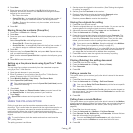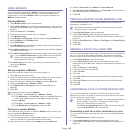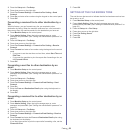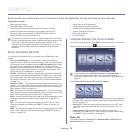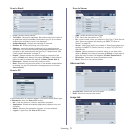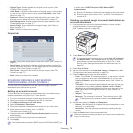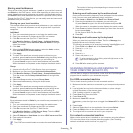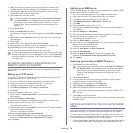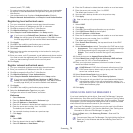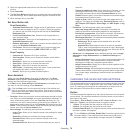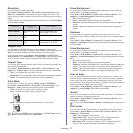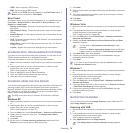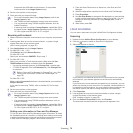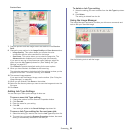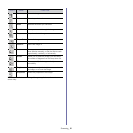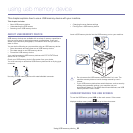
Scanning_ 75
network (email, FTP, SMB).
• For network scanning using the authentication feature, you must register
the network or local authentication configuration using the SyncThru™
Web Service.
• User authentication has 3 options: No Authentication (Default),
Require Network Authentication, and Require Local Authentication.
Registering local authorized users
1. Turn your networked computer on and open the web browser.
2. Enter your machine's IP address as the URL in a browser.
3. Click Go to access the SyncThru™ Web Service.
4. Click Machine Settings > User Authentication.
5. Select Require Local Authentication in the Setup section.
If you have not set Default[From:] Address in SMTP Client
Setup, the notifying pop-up window appears. Click OK to browse
the Web page where you can set the default email address.
6. Click Apply.
7. Click OK in the modifying confirmation pop-up window.
8. Select Local Authentication in the left pane.
9. Click Add.
10. Select an index number corresponding to the location for storing the
entry, from 1 to 50.
11. Enter your name, auth ID, password, e-mail address and phone number.
You need to enter the registered user ID and password in the machine
when you start scanning to email from the control panel.
12. Click Apply.
Register network authorized users
1. Turn your networked computer on and open the web browser.
2. Enter your machine's IP address as the URL in a browser.
3. Click Go to access the SyncThru™ Web Service.
4. Click Machine Settings > User Authentication.
5. Select Require Network Authentication in the Setup section.
If you have not set Default[From:] Address in SMTP Client
Setup, the notifying popup window appears. Click OK to browse
the web page where you can set the default email address.
6. Click Apply.
7. Click OK in the modifying confirmation popup window.
8. Select the Authentication Type that you prefer.
Configure the values for each feature, as follows:
Kerberos
1. Select Kerberos.
2. Enter the Default Realm used for Kerberos login.
3. Select IP Address or Host Name.
4. Enter the IP address in dotted decimal notation or as a host name.
5. Enter the server port number, from 1 to 65535.
The default port number is 88.
6. You can add a backup domain as a previous step.
7. Click Apply.
SMB
1. Select SMB.
2. Enter the domain that is used for SMB login.
3. Select IP Address or Host Name.
4. Enter the IP address in dotted decimal notation or as a host name.
5. Enter the server port number, from 1 to 65535.
The default port number is 139.
6. User can add a backup domain as in the previous step.
7. Click Apply.
User can add up to 6 optional domains.
LDAP
1. Select LDAP.
2. Click Apply.
3. Click OK in the modifying confirmation pop-up window.
4. Click LDAP Server Setup in the left pane.
5. Select IP Address or Host Name.
6. Enter the IP address in dotted decimal notation or as a host name.
7. Enter the server port number, from 1 to 65535.
The default port number is 389.
8. Enter Search Root Directory, the top search level of the LDAP
directory tree.
9. Select Authentication method. Two options for LDAP server login.
• Anonymous: This is used to bind with null password and login
ID (Password and login ID are grayed out in SWS).
• Simple: This is used to bind with the login ID and password in
SWS.
10. Check the box next to Append Root to Base DN.
11. Select Match User’s Login ID to the following LDAP attribute
(options are CN, UID, or UserPrincipalName).
12. Enter your login name, password, maximum number of search
results and search timeout.
LDAP Referral: LDAP client will search referral server if the
LDAP server has no data to reply to query and if the LDAP
server has a referral server.
13. Select Search Name Order that you desire.
14. Check the box next to "From:" Field Security Options.
This option is only provided if you have selected the Network
authentication option in the user authentication setting. You
may check this option if you want to search for information in a
default email address group.
15. Click Apply.
USING SCAN AND FAX MANAGER 2
If you have installed the printer driver, Scan and Fax Manager 2 program
has installed too. Start Scan and Fax Manager 2 program to find out about
this program information and the installed scan driver's condition. Through
this program, you can change scan settings and add or delete the folders
where scanned documents are saved in your computer.
Scan and Fax Manager 2 program can only be used in the Window
and Macintosh system. If you use the Macintosh, See
"Setting scan
information in Scan and Fax Manager" on page 79.
1. From the Start menu, click Samsung Printers > Scan and Fax
Manager 2.
You can open Scan and Fax Manager 2 by right clicking the Smart
Panel icon in the Windows task bar and seleting Scan and Fax
Manager 2.



